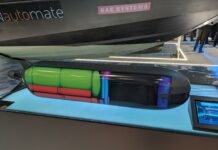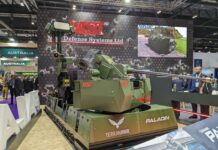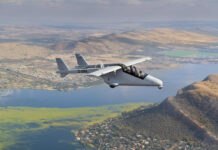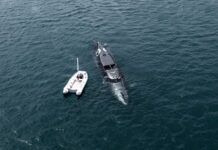The four companies responsible for the integrated sensing and non-kinetic effects & integrated communications systems (ISANKE & ICS) domain for the Global Combat Air Programme (GCAP) stated at the DSEI 2023 exhibition that they are close to agreeing a commercial and operating arrangement to deliver the new combat aircraft’s onboard electronics.
This latest development follows the signing of an ISANKE & ICS domain collaboration agreement in March and moves the partners closer to the creation of a permanent industrial construct.
Speaking to an audience at DSEI 2023 on 12 September, senior officials from Leonardo UK, Japan’s Mitsubishi Electric, and Leonardo and ELT Group of Italy were keen to emphasise that their efforts in addressing the ISANKE & ICS domain are maintaining momentum. This is crucial if the GCAP programme is to achieve its very ambitious goal of delivering a first next-generation fighter from 2035.
“Pace is really important,” emphasised Andrew Howard, director of Future Combat Air/GCAP at Leonardo UK, but he added that “We are seeing the achievement of those timelines. … The strength of the collective team is what’s unlocking the pace of the programme.”
The company representatives spoke of good progress with both the commercial construct of the three-nation ISANKE & ICS effort as well as the considerable technical challenges presented by the programme.
Howard noted that “trust, co-operation and a willingness to share” were essential elements of the programme, into which is built “both freedom of action and freedom of modification”.
Luca Picollo, senior vice president of airborne systems for Leonardo Electronics in Italy, noted that “to make the partnership work, we had to design a new, closer business relationship” and that the four companies are “now assessing the commercial models on which the programme goes forward”.
Giovanni Zoccali, ELT Group’s vice president for Europe and consortia, sales and business development, added that the cultural differences between the three GCAP nations had led to different points of view that ultimately have had a positive effect on the programme. “An initial constraint became an important advantage,” he said.
In addition to commercial discussions, over the last few months the domain partners have also made significant progress on the technical side of the programme, with the ISANKE & ICS subsystem passing a three-nation systems review. Although the companies could not divulge the specifics of that technical progress, Hammond told the DSEI 2023 audience that the partners have “clarity of what we think the system looks like” as well as “certainty of where we need to make investments”.

Howard added that ISANKE & ICS is a new system layer: something that has not been present in previous platforms that requires the integration of sensors at a profound level. The GCAP aircraft is expected to have numerous sensors widely distributed around it and deeply integrated within it.
Isamu Suda, deputy senior general manager for Mitsubishi Electric, added that the GCAP programme was leading some of the most cutting-edge work being done anywhere to be taking place in the three partner countries, which he said would “expertise our nations for the future”.
The company representatives also mentioned the progress with future ISANKE and ICS testing. On 14 July this year Leonardo UK announced a contract from the UK Ministry of Defence worth around EUR 134 M covering the next stage of the Excalibur Flight Test Aircraft (FTA) project: a key part of the GCAP programme. The Excalibur FTA, a converted Boeing 757, will host the ISANKE and ICS assets that the GCAP partners are developing and is scheduled to make its first flight in 2026.
Peter Felstead












